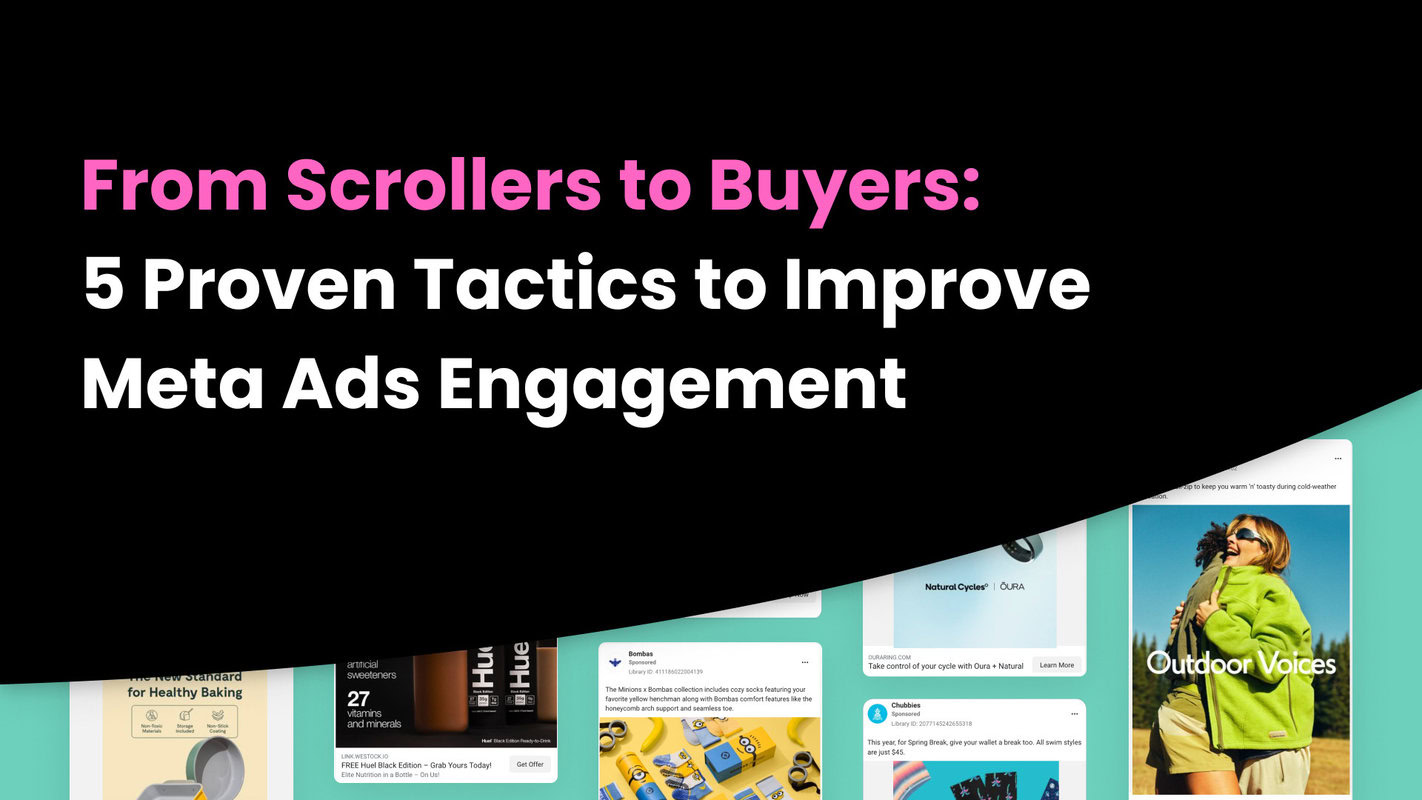Meta ads are everywhere (and we mean everywhere!) but despite their prominence, not all of them do their job – drive sales.
And if your ads aren’t grabbing attention, sparking interest, or getting clicks, they’re just background noise. That’s why Meta ads engagement is the metric that really matters.
Here’s a stat to think about – Facebook’s average CTR (click-through rate) across all industries is a slim 0.9%. Yikes! But the brands that understand why Meta ad engagement matters are breaking through that barrier and turning casual scrollers into dedicated buyers.
So how do they do it?
To answer this question, we dove into 101 Meta ads from top-performing DTC brands across industries.
From bold visuals to authentic messaging, these ads proved there’s more than one way to win attention and boost engagement. After breaking them down, we found five key tactics any brand can use to improve their ads and see real results.
In this post, we’ll gonna share those tactics so you can level up your Meta ad engagement and start turning scrollers into buyers. Let’s take a look.

Tactic 1: Use User-Generated Content (UGC) to Build Trust
How UGC Boosts Meta Ad Engagement
People trust other people more than they trust brands. A shiny ad from your company might look great, but it’s those raw, unfiltered testimonials from real customers that truly resonate.
Studies show that 79% of people say UGC highly impacts their purchasing decisions. That’s why UGC for Meta ads engagement is such a big deal.
User-generated content adds a layer of authenticity to your Meta ads, making them feel less like marketing and more like a recommendation from a friend.
Think about it…would you trust a brand’s claim that their product works wonders or would you trust a customer showing real results? Duh.
Take Nutrafol, for example. Their Meta ads often feature UGC, like glowing testimonials from real customers showcasing how the product helped their hair transformation.
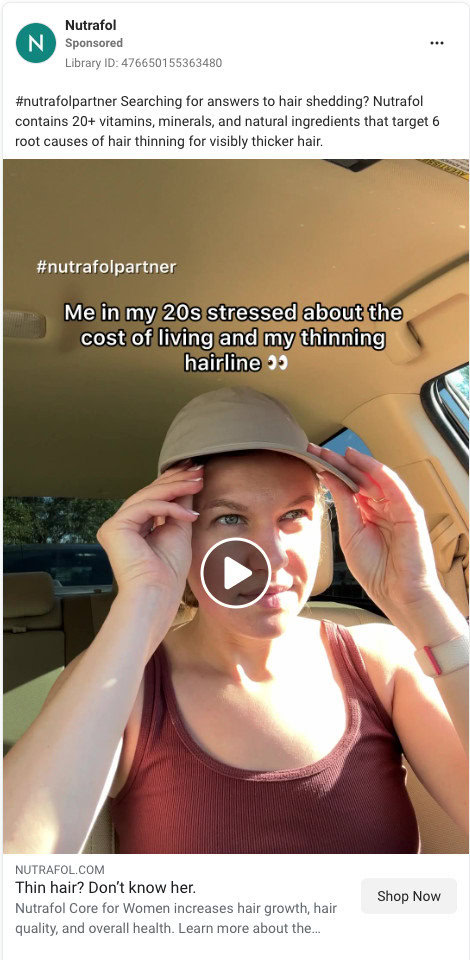
These ads stand out because they’re relatable, believable, and grounded in real-life experiences.
Actionable Tips to Leverage UGC
- Source UGC from your community: Encourage customers to tag you on social media or submit reviews. This gives you a treasure trove of real content to repurpose.
- Pair UGC visuals with clear CTAs: Show a customer using your product, and follow it with a simple, actionable message like “Shop Now” or “See the Results for Yourself.”
- Keep it authentic: Don’t over-edit UGC; leave it raw and real. That’s what makes it resonate.
The cool thing about UGC is you aren’t just promoting your product, you’re showing real, tangible proof that it works and that’s the ultimate trust-builder.
Tactic 2: Highlight Pain Points and Offer Solutions
Meta Ads That Solve Problems Engage Better
People don’t just scroll endlessly through Meta looking for products. They’re looking for something. They are looking for solutions.
Highlighting a specific pain point your audience faces grabs their attention because it’s immediately relatable. Addressing these challenges head-on shows your audience that you get them and that your product is the answer they’ve been waiting for.
Why does this work?
According to research, ads that highlight problem-solving benefits are 31% more likely to drive engagement compared to those that simply showcase features.
That’s the power of empathy in marketing.
A great example of this is Knix. One of their Meta ads highlights the frustrations of outdated, bulky pads and offers a sleek, comfortable alternative with their period underwear.
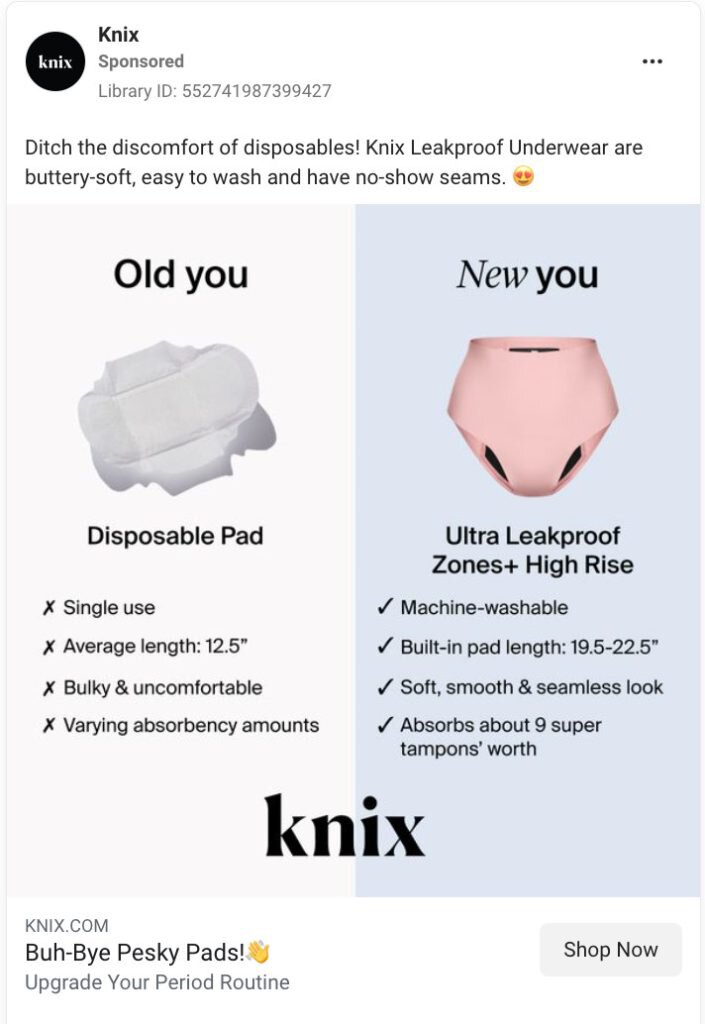
The visuals drive it home with a side-by-side comparison: clunky old pads versus modern, seamless underwear. The message is clear. Knix understands the problem and has a better solution.
Actionable Tips to Create Problem-Solving Meta Ads
- Identify Your Audience’s Biggest Challenges:
Pinpoint what frustrates your audience the most about the current options in your industry. Position your product as the game-changing solution. - Use Visual Contrasts:
Before-and-after shots, side-by-side comparisons, or simple visuals that emphasize the “problem vs. solution” dynamic are incredibly effective. - Keep the Message Clear:
Focus your copy and visuals on the solution. Don’t overcomplicate it—simple, direct messaging resonates the most.
When your Meta ads demonstrate that you understand your audience’s challenges and offer a real solution, you’re doing more than just selling a product, you’re providing value that resonates.
Tactic 3: Create a Sense of Urgency
Why FOMO Drives Meta Ad Engagement
If there’s one thing that gets people to stop scrolling and take action, it’s the fear of missing out. I can’t tell you how many things I’ve bought cause a sale was ending or a product was going out of stock.
Adding urgency to your Meta ads makes your audience feel like they need to act now. Not later, not tomorrow, but right this second!
Whether it’s a flash sale, a countdown timer, or a “back in stock” alert, urgency creates a psychological nudge that’s hard to resist.
Like I said, it works. Studies show that limited-time offers can increase conversion rates by up to 332%.
Misfits Market leverages this brilliantly with “back in stock” ads. Their Meta ad featuring ribeye steaks grabs attention by teasing, “What’s wrong with it?” before revealing it’s perfectly good food at discounted prices.
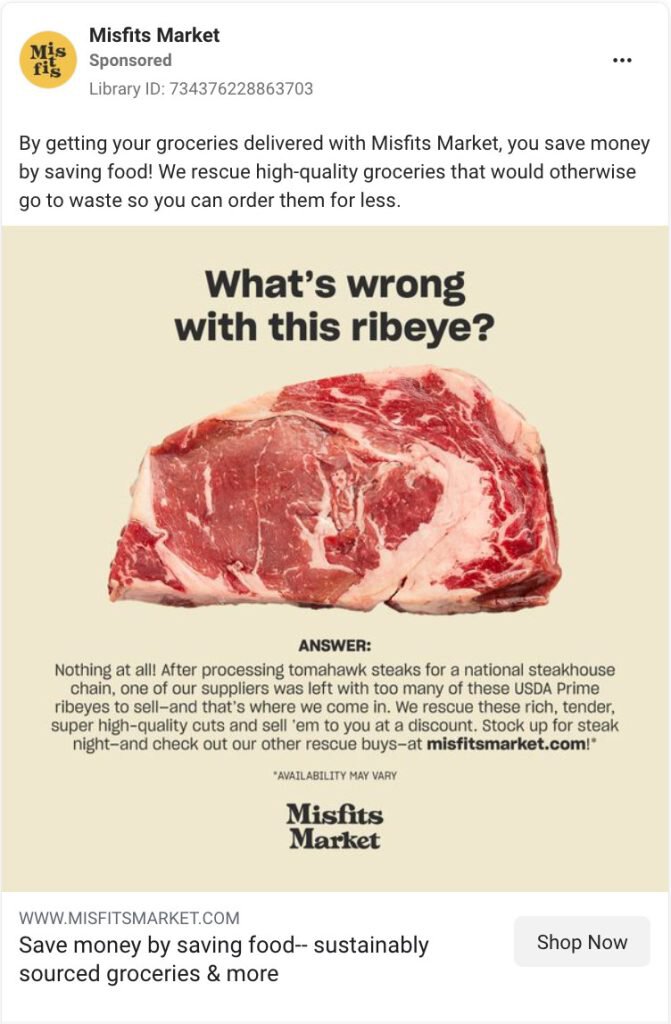
The back-in-stock messaging adds a sense of exclusivity, making customers feel like they’re getting a rare deal.
Actionable Tips to Add Urgency to Your Meta Ads
- Use Countdown Timers or Urgent Phrases:
Phrases like “Only 2 Days Left” or “Offer Ends at Midnight” tap into that FOMO feeling and encourage immediate clicks. - Incorporate Urgency into Retargeting Ads:
For hesitant buyers, create ads that remind them of what they’re missing. Phrases like “Items in Your Cart Are Selling Out” can push them toward a decision. - Highlight Limited Availability:
Let your audience know when something is running low. Words like “Exclusive,” “Only a Few Left,” or “Back by Popular Demand” can drive engagement by adding scarcity to the mix.
Remember that urgency isn’t the same as being pushy. It’s not a shove, it’s a nudge to get them to act before it’s too late.
Tactic 4: Test, Analyze, and Refine Creative Elements
Optimize Your Meta Ads with Creative Testing
No matter how good your first Meta ad might seem, there’s always room for improvement and that’s why we gotta test, test, test.
Testing isn’t just an extra step, it’s essential to figuring out what truly resonates with your audience.
By running A/B tests and analyzing the results, you can fine-tune your visuals, messaging, and targeting to maximize Meta ads engagement.
AND – Ads that are optimized through creative testing see engagement rates improve by as much as 300%. Seems like the right thing to do.
Vuori is a great example of how testing drives results. The brand consistently experiments with different imagery, messaging styles, and ad formats to find the perfect blend of creativity and audience appeal.
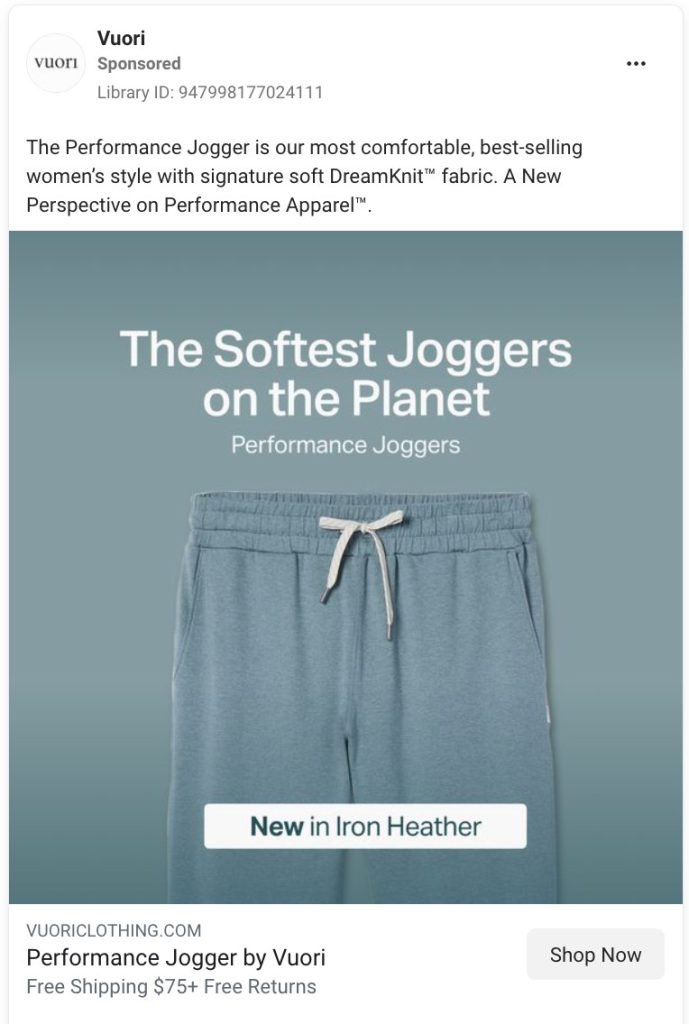
By analyzing what works best, they’re able to refine their ads and keep their engagement rates high.
Actionable Tips to Improve Meta Ad Engagement with Testing
- Run A/B Tests:
Experiment with different ad visuals, headlines, copy, CTAs, and targeting options. Test one variable at a time to see what makes the biggest difference. - Leverage Meta’s Reporting Tools:
Use Meta’s built-in analytics to track metrics like CTR, conversion rate, and engagement. Look for patterns in high-performing ads to replicate success. - Refine Based on Results:
Take what you learn from your tests and apply it. If a certain visual drives more clicks, make it a central element in your next campaign. If a CTA underperforms, test alternatives until you find one that works.
Testing isn’t a one-and-done process. It’s an ongoing strategy to keep your ads fresh, engaging, and effective.
Tactic 5: Leverage Visual Storytelling
Make Your Meta Ads Memorable with Visual Storytelling
A picture might be worth a thousand words, but a compelling visual story? That’s priceless.
Visual storytelling taps into emotions, grabs attention, and conveys your brand’s value faster than any block of text ever could. With just a glance, your audience can understand who you are, what you offer, and why they should care.
That’s the magic of visual storytelling for Meta ads engagement.
Why does this work? Because our brains process visuals 60,000 times faster than text, making strong imagery your best tool for turning scrollers into buyers.
Take Hungryroot, for example. One of their Meta ads shows a dull, empty fridge transforming into a vibrant, colorful one packed with healthy, prepped meals.
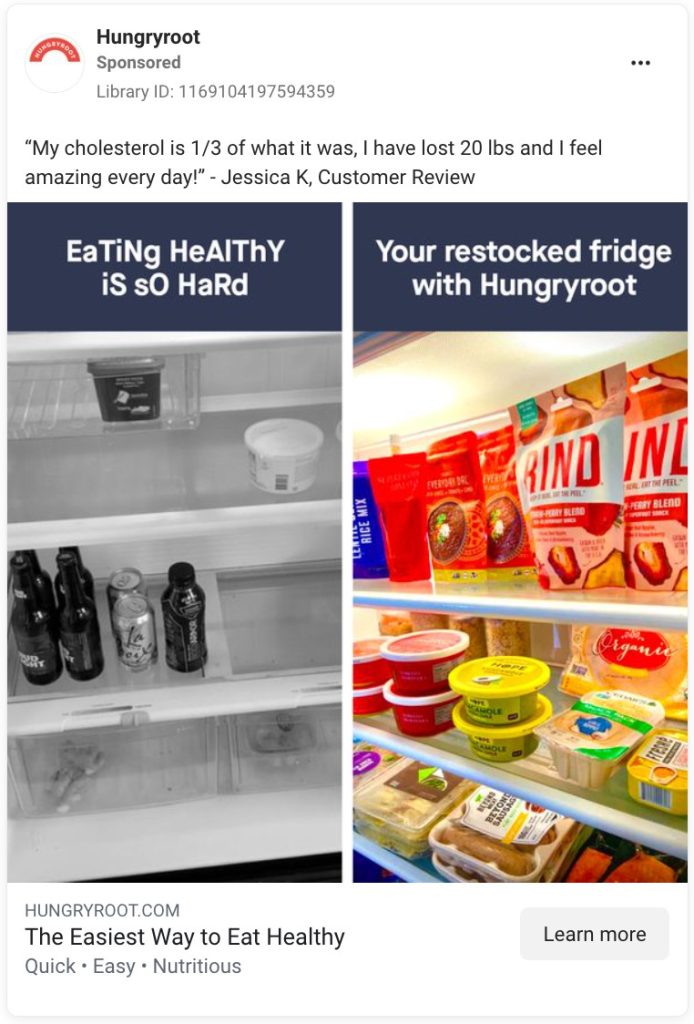
No lengthy captions needed—the visuals instantly tell the story of convenience, health, and transformation. It’s simple, eye-catching, and incredibly effective.
Actionable Tips to Add Visual Storytelling to Your Meta Ads
- Use Imagery That Tells a Quick Story:
Show transformations (e.g., before-and-after shots), lifestyle moments, or product demonstrations that illustrate your brand’s impact in seconds. - Keep Visuals Consistent with Your Brand Identity:
From colors to fonts to tone, ensure your visuals are unmistakably “you.” Consistency builds trust and makes your ads instantly recognizable. - Leverage Video for Stronger Storytelling:
If a picture is worth a thousand words, a short video can be worth a million. Use video to create mini-narratives that draw your audience in and keep them engaged.
When you use visual storytelling in your Meta ads, you’re not just showing your product, you’re inviting your audience to imagine how it fits into their life.
Bonus Tactic: Target High-Intent Audiences
Why Reaching the Right Audience Matters for Meta Ad Engagement
Even the best ad won’t perform if it’s shown to the wrong people. That’s why targeting high-intent audiences (those already familiar with your brand) can significantly boost your results.
These are the folks who’ve visited your site, engaged with your content, or shown interest in what you offer. They’re already intrigued and that makes them far more likely to engage.
How do we know this? Cause it’s what we do!
Using Customers.ai Meta Ads Audiences instead of traditional Facebook Pixel targeting can produce 2x ROAS (Return on Ad Spend).
Why? Because these audiences are made up of higher-intent users who already know you exist. Instead of casting a wide net, you’re focusing your budget on people who are primed to take action.
How This Boosts Engagement
When you target people with some level of familiarity your Meta ads become way more relevant. These users are already aware of your brand, so your messaging doesn’t have to work as hard to explain who you are. Instead, you can focus on what matters and why they should take the next step.
Here’s an example. An ad retargeting people who visited your product page but didn’t convert could emphasize a limited-time discount or showcase testimonials to nudge them toward purchase.
The engagement comes naturally because you’re delivering ads to people who already have a reason to care.
Actionable Tips for Targeting High-Intent Audiences
- Leverage Customers.ai Audiences: Build audiences of site visitors and high-intent users using visitor identification for precise targeting. These people are already primed to engage, so make the most of your budget.
- Use Retargeting Ads: Serve ads specifically to people who’ve visited your website, abandoned their cart, or interacted with your brand on social media.
- Focus on Relevance: Tailor your messaging to their behavior. For example, if they visited your product page, emphasize features, benefits, or testimonials in your ad.
When you target high-intent audiences, you’re reaching the right people. And that’s the secret to maximizing Meta ads engagement while boosting your ROAS.
Key Takeaways: Turning Scrollers into Buyers
Boosting Meta ads engagement isn’t about guessing. It’s about using proven tactics that work and adapting them to fit your brand and audience.
Let’s recap the 5 strategies that can take your ads from background noise to scroll-stopping winners:
- Use User-Generated Content (UGC) to Build Trust: Show real customers and their experiences to add authenticity and credibility to your ads.
- Highlight Pain Points and Offer Solutions: Address your audience’s challenges and position your product as the perfect fix.
- Create a Sense of Urgency: Use FOMO-driven tactics like countdowns, limited-time offers, or back-in-stock alerts to spark immediate action.
- Test, Analyze, and Refine Creative Elements: Continuously experiment with visuals, copy, CTAs, and targeting to find what resonates.
- Leverage Visual Storytelling: Use compelling imagery and videos to create emotional connections and showcase your brand’s value.
Experiment, Adapt, Succeed
The key to success? Experiment with these tactics, track what works, and tweak your approach as you learn more about your audience.
Ready to start turning scrollers into buyers? Apply these strategies to your next campaign, and watch your Meta ads go to work.
Need more inspiration? Download our free ebook, 101 Meta Ads from Top DTC Brands to Inspire Your Next Campaign, packed with 101 Meta ad examples to give you the ideas and insights you need to level up your campaigns.

Important Next Steps
- See what targeted outbound marketing is all about. Capture and engage your first 500 website visitor leads with Customers.ai X-Ray website visitor identification for free.
- Talk and learn about sales outreach automation with other growth enthusiasts. Join Customers.ai Island, our Facebook group of 40K marketers and entrepreneurs who are ready to support you.
- Advance your marketing performance with Sales Outreach School, a free tutorial and training area for sales pros and marketers.
FAQs: Meta Ads Engagement
1. What is Meta ads engagement, and why is it important?
Meta ad engagement refers to how users interact with your Meta ads, including clicks, likes, shares, comments, and saves. High engagement shows that your ad resonates with your audience and can lead to better brand awareness, conversions, and ad performance. Meta’s algorithm often rewards ads with higher engagement by prioritizing them in feeds, helping you get more visibility for less spend.
2. How do I measure engagement in my Meta ads?
You can measure engagement using Meta’s Ads Manager, which tracks key metrics like click-through rate (CTR), likes, comments, shares, and engagement rate. Look for patterns in high-performing ads to identify what resonates most with your audience. Pay attention to CTR and conversion rates specifically, as these directly correlate with ad effectiveness.
3. What’s the quickest way to improve Meta ads engagement?
One quick way to improve engagement is by updating your visuals to be more eye-catching or relatable. You can also test new copy that speaks directly to your audience’s needs or pain points. Adding a sense of urgency, such as limited-time offers or countdown timers, is another effective way to boost engagement quickly.
4. What are the most effective strategies to boost Meta ads engagement?
Some of the most effective strategies include:
- Using UGC: Showcase real customer experiences for authenticity.
- Highlighting Pain Points: Address specific challenges your audience faces and offer solutions.
- Creating Urgency: Use limited-time offers or “back in stock” alerts to drive action.
- Testing and Refining: Run A/B tests on visuals, copy, and CTAs to optimize performance.
- Visual Storytelling: Use imagery that tells a compelling brand story to grab attention.
5. Why do some Meta ads fail to engage users?
Ads often fail when they lack relevance to the audience or don’t stand out visually. If your targeting is too broad, your ad might reach people who aren’t interested in your product or service. Additionally, ads with overly generic messaging or poor-quality visuals tend to perform poorly in terms of engagement.
6. How does user-generated content (UGC) impact Meta ads engagement?
UGC builds trust by showcasing real customers and their experiences. People are more likely to engage with content that feels authentic and relatable. Incorporating UGC in your Meta ads can lead to higher engagement rates and stronger connections with your audience.
7. What role do visuals play in improving Meta ads engagement?
Visuals are critical, as people process them much faster than text. High-quality, compelling visuals can grab attention and convey your message in seconds. Using dynamic formats like videos, carousels, or before-and-after imagery can also make your ads more engaging.
8. How can I use storytelling to increase Meta ads engagement?
Storytelling helps create an emotional connection with your audience, making your ads more memorable. Use visuals and copy that together tell a quick, relatable story. For example, before-and-after shots, transformation videos, or testimonials can highlight your product’s value in a way that feels genuine and impactful.
9. What’s the best way to test my Meta ads for engagement?
The best approach is A/B testing. Run two or more versions of the same ad with slight differences in visuals, headlines, or CTAs. Analyze performance data from Meta’s Ads Manager to see which version generates the highest engagement and apply those learnings to future campaigns.
10. Why is targeting important for Meta ads engagement?
Targeting ensures your ads reach people who are most likely to be interested in your product. By focusing on high-intent audiences, like those who’ve visited your website or interacted with your brand, you can drive more relevant engagement. Proper targeting saves ad spend and improves overall performance.
11. What types of Meta ads drive the most engagement?
- Carousel Ads: Showcase multiple products or features in one ad.
- Video Ads: Short, engaging videos grab attention quickly.
- UGC-Based Ads: Build trust with real testimonials or customer photos.
- Interactive Ads: Polls, quizzes, or swipeable content encourage active participation.
12. How does urgency affect Meta ads engagement?
Urgency creates FOMO (fear of missing out), which encourages users to act quickly. Ads with limited-time offers or “only a few left” messaging tend to drive more clicks and conversions. Pairing urgency with a strong CTA amplifies this effect.
13. How often should I refresh my Meta ads to maintain engagement?
Refreshing your ads every 2–4 weeks is a good rule of thumb. This prevents ad fatigue, where users start ignoring ads they’ve seen too often. Rotate visuals, update messaging, or test new formats to keep your audience interested.
14. How can I use Meta’s reporting tools to improve ad engagement?
Meta’s Ads Manager provides detailed metrics like CTR, engagement rate, and ROAS (Return on Ad Spend). Use this data to identify high-performing elements in your ads, such as visuals or copy, and replicate those successes in future campaigns.
15. How does high engagement impact my ad spend?
High engagement signals to Meta’s algorithm that your ad is valuable, often leading to lower CPM (cost per thousand impressions). This means you can reach more people for less money while still driving strong results.
16. Should I prioritize engagement or conversions in my Meta ads?
It depends on your campaign goals. If you’re building brand awareness, focus on engagement to spark initial interest. If you’re targeting people further down the funnel, prioritize conversions while maintaining engaging ad content.
17. How do I use UGC effectively in my Meta ads?
- Ask customers for reviews or photos using your product.
- Feature raw, unpolished visuals to keep things authentic.
- Pair UGC with strong CTAs like “Shop Now” or “Learn More.”
18. Can I improve Meta ads engagement without increasing my budget?
Yes! Focus on optimizing targeting, improving visuals, and refining copy. Testing different ad formats and leveraging UGC can also boost engagement without requiring additional spend.
19. What’s the role of CTAs in boosting Meta ads engagement?
CTAs guide users on what to do next, whether it’s “Shop Now,” “Learn More,” or “Sign Up.” A strong, clear CTA paired with engaging visuals ensures your audience knows exactly how to interact with your ad.
20. How does retargeting improve Meta ads engagement?
Retargeting lets you reach users who’ve already interacted with your brand, like visiting your website or adding items to their cart. These warm audiences are more likely to engage because they’re already familiar with your product or service.
21. Are video ads better for Meta ads engagement?
Video ads often outperform static ads because they’re dynamic and attention-grabbing. Use short, engaging videos to showcase your product’s value quickly and visually.
22. How do I handle negative engagement on my Meta ads?
Respond to negative comments professionally and quickly. Address concerns openly to show you value customer feedback, and use the opportunity to demonstrate excellent service.
23. How do carousels improve Meta ads engagement?
Carousels let you highlight multiple products, features, or benefits in one ad. This interactive format encourages users to swipe through, increasing engagement time and interest.
24. What’s the best way to address pain points in Meta ads?
Focus your copy and visuals on your audience’s specific challenges and offer a clear solution. Highlight benefits over features and use testimonials or comparisons to back up your claims.
25. Can high-quality visuals alone improve Meta ads engagement?
Yes, but pairing visuals with relevant copy and targeting maximizes their impact. A strong visual catches attention, but engaging messaging and proper audience targeting close the loop for meaningful engagement.
